Beijing Day 2
This is the second post in a series - for the first, see Beijing Day 1.
On the second day in Beijing we went to the Summer Palace, a former imperial palace in the hills on the edge of the city. It was used as a retreat from the crowds and heat (both for the imperial court as well as modern-day tourists). The main attractions are a hill overlooking a large lake - the former apparently built out of the land excavated while digging the latter (requiring the work of 100,000 laborers).
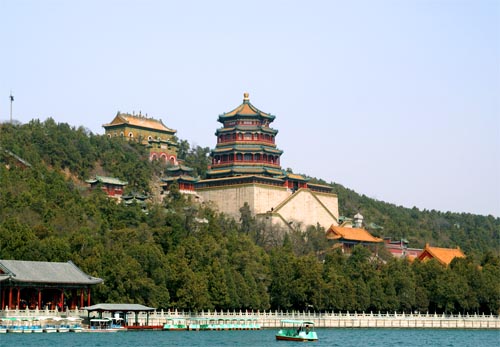
The buildings and a large Buddhist temple overlook the lake.

The view from the top of the temple shows the lake, whose causeways and islands were patterned off the West Lake in Hangzhou (about which there will be more in an upcoming post on Shanghai).
As with the Forbidden City, much of the original architecture and artifacts have been destroyed - this time during the Opium Wars by British and French troops. After the wars, the Empress Dowager Cixi rebuilt much of the Summer Palace to her own liking, including this large marble boat:
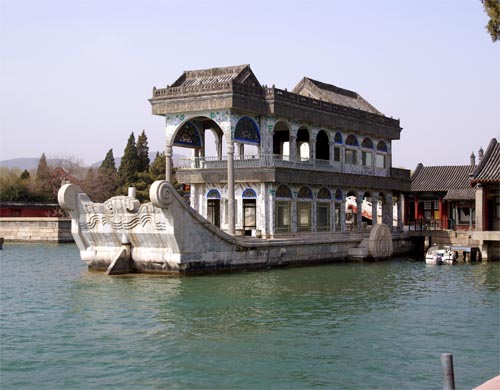
Along with other things, it was built using funds meant to be used to rebuild the Chinese armed forces. Not surprisingly, what remained of her empire was overrun by the revolution of 1911 only a few years later.
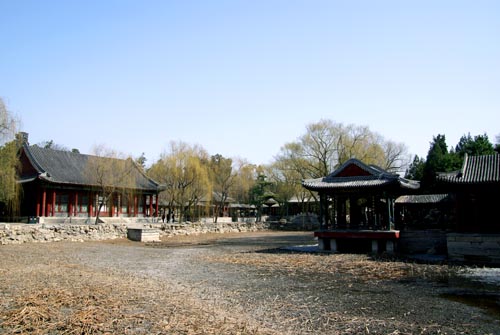
This garden would likely have been much more impressive with water in it.

A large Buddha statue, with a "No Pictures" sign.
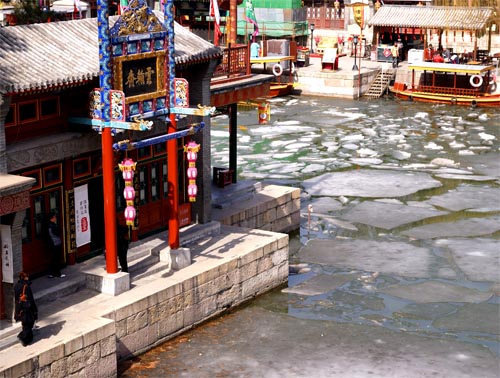
Behind the hill there was a river with a small "town," which turned out to be a trap - once inside, you could not get out until you walked along the whole thing, past lots of little shops hawking various things.

Apparently breaking the ice is a manual process, requiring one guy to do the work and two to watch.
After the Summer Palace we decided to explore around town by foot for a bit. This turned out to be a more interesting experience than I had expected. It quickly became apparent that pedestrians do not have the right of way anywhere near the streets - in fact, the "right of way" is a somewhat nebulous concept in China. If a car is coming, it's not going to stop, so you had better get out of the way. There are occasionally "walk" signals at intersections, but these seem to be mere suggestions. It took me a while to get up the nerve to cross large streets until I realized that I would just need to accept a higher level of risk of bodily harm than I am accustomed to. Once you get past that, it feels sort of like playing a video game (like Frogger), except if you lose a life, it is your own.
Unfortunately we didn't stop to take many pictures that really captured the experience, but it was very much like the famous "Driving in India" YouTube video that made the rounds a couple years ago (an interesting one to watch if you haven't seen it). Here are a couple pictures we did manage to take:

Still pictures don't really capture how cars were just going in all directions at all times.

Scenes like this were common - people would carry what appeared to be entire apartments' worth of furniture on their bikes, sometimes with assist motors but just as often without.
Once in a car, things felt a little safer, but not by a whole lot. About the only traffic rules which really seemed to be followed were: drive on the correct side of the road, stop if a stoplight has been red for a while, and mostly try to stay within the marked lanes, although these rules were pretty flexible. Turn signals are not used - if you want to change lanes, you just go for it and stick your hood in, trusting that you will not be hit by the car formerly occupying that space. Riding in a Taxi was often a harrowing experience, only abated by the fact that most of the time you were traveling fairly slowly due to the terrible traffic. There were no seatbelts in the back of the taxis. Once I became quite worried when it looked like the driver had actually decided to put on his seatbelt while flying down a highway at high speed, but he was actually only just reaching to answer his mobile phone.
Taxis are very cheap - they cost 10 RMB plus 2 RMB per km traveled, meaning that you can travel halfway across the city for only a couple of USD. We ended up taking taxis everywhere we went in Beijing since they were so cheap, fast and direct. There weren't many other good options (the subway system is still mostly under construction, and it was impossible to decipher the Chinese schedules for the buses, which were overcrowded anyway). Apparently many tourists find it cheap enough to actually hire a private car and driver while in Beijing. We didn't do that because the taxis worked fine as long as we had a written Chinese version of the address where we were going. We never really encountered any problems with the taxi drivers. Apparently if any complaints are made against the drivers, they will be fined a couple months' worth of salary, which keeps them in line (a friend also told us a rumor that the communist government recently executed some drivers for scamming tourists, but The Google wasn't able to confirm that one). Still, there were a couple of times when we would ride somewhere for 20 RMB, and the return trip would cost us 11 RMB (so clearly at least one driver had "accidentally" gone the completely wrong way), but we never bothered to make a fuss.
That about wrapped up Day 2 in Beijing, though we also stopped by MSR China:
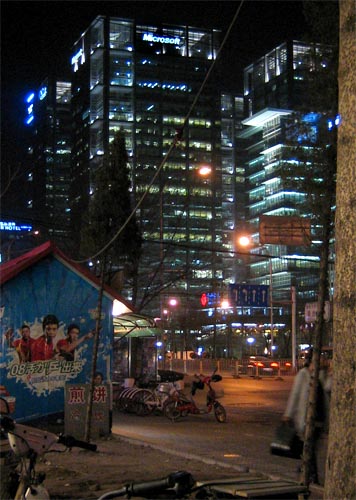
It's not visible in the picture, but immediately behind the Microsoft building is a giant Google building.



April 9th, 2009 - 05:19
Really like the look and the idea of a marble boat. Marble?!
And the traffic and driving situation sounds horrifying…You and Angela are lucky you survived!